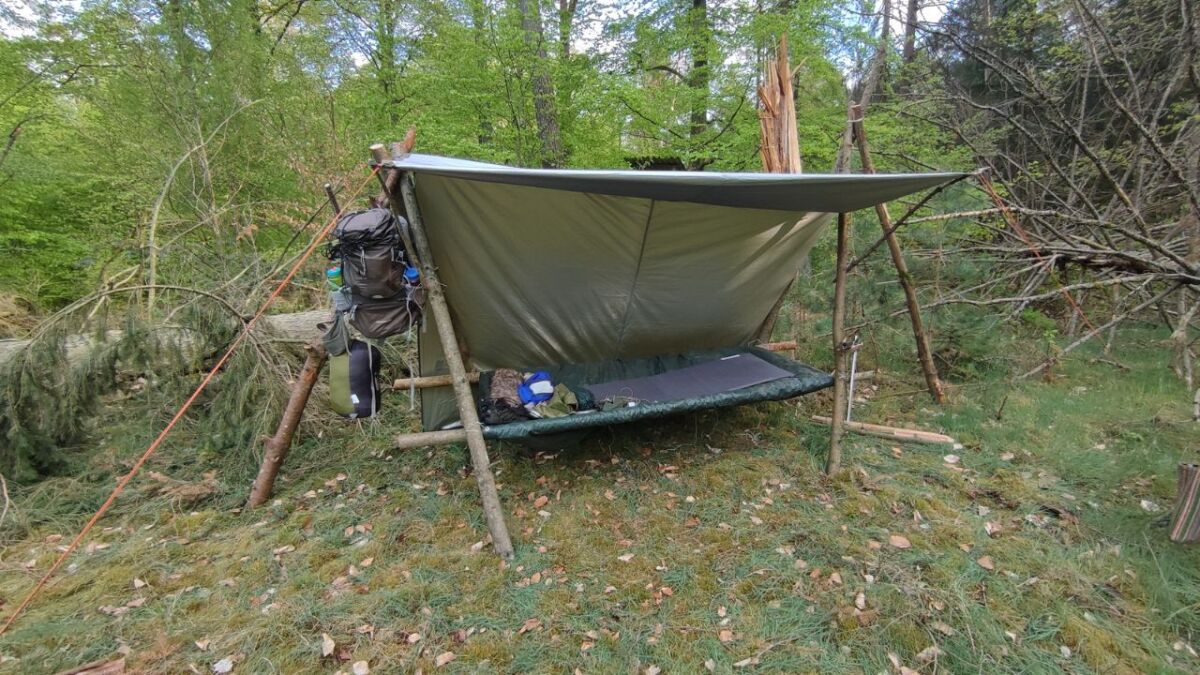
forest bed
Nomen
Meaning
The term "forest bed" refers to a natural sleeping arrangement made in the wilderness using materials found in the forest. It is a crucial skill in survival, bushcraft, and camping, as it provides insulation and comfort while sleeping outdoors. To create a forest bed, one typically gathers leaves, moss, and other soft materials to create a thick layer on the ground. This layer acts as a barrier between the body and the cold, damp ground, helping to retain body heat and improve sleep quality. Mastering the art of creating a forest bed is essential for anyone venturing into the great outdoors.

Examples
„I love setting up my camp in the forest bed. It's so comfortable and cozy, surrounded by the sounds of nature.“
„When I go hiking, I always make sure to find a good spot to rest on a soft forest bed. It's a great way to recharge and enjoy the beauty of the wilderness.“
„During my survival training, I learned how to make a forest bed using leaves and branches. It provides insulation from the cold ground and helps me stay warm at night.“
„My friend and I were discussing our camping experiences, and he mentioned how he found a perfect forest bed under a big tree. It was like sleeping on a cloud!“
„As I was exploring the woods, I stumbled upon a hidden clearing with a natural forest bed. It was a peaceful spot to take a break and soak in the serenity of the surroundings.“
Origin
The word "forest bed" originates from the combination of the words "forest" and "bed." The term refers to a natural sleeping arrangement or makeshift bed made in the forest or wooded areas. It has its roots in the practice of survival and bushcraft, where individuals create comfortable sleeping spaces using materials found in the surrounding environment.
The concept of a forest bed has evolved over time as people have honed their skills in wilderness survival. In the past, it was common for people to simply lay down on the forest floor, using leaves, moss, or other natural materials as a cushion. However, with advancements in knowledge and techniques, individuals now construct more elaborate forest beds using branches, logs, and foliage to create a raised platform.
Today, the forest bed is a popular topic among outdoor enthusiasts, survivalists, and those interested in reconnecting with nature. It is seen as a way to enhance comfort and safety while spending extended periods in the wilderness. The term "forest bed" has become a recognized term within the lexicon of survival and bushcraft, representing the ingenuity and resourcefulness of those who venture into the wild.
Synonyms
Forest floor, Woodland ground, Forest ground, Woodland floor, Forest ground cover, Forest undergrowth, Forest litter, Forest debris
Antonyms
Open field, Desert, Beach, Prairie, Tundra, Steppe, Savannah, Meadow
Relatives
Wilderness, Camping, Outdoor, Nature, Survival, Bushcraft, Hiking, Shelter
Historical and cultural importance
The term "forest bed" refers to a specific type of natural bedding found in the wilderness. Historically, forest beds have been used by indigenous cultures and early settlers as a means of creating a comfortable sleeping surface in the wild. These beds are typically made by layering various materials found in the forest, such as leaves, moss, and branches, to create a soft and insulating surface.
Forest beds have a significant cultural relevance as they have been used for centuries by people living close to nature. Indigenous communities around the world have developed their own techniques and knowledge for creating forest beds that provide both comfort and protection from the elements. These beds were not only used for sleeping but also served as a way to connect with the natural environment and maintain a close relationship with the land.
In addition to their cultural significance, forest beds also have a practical historical relevance. Early settlers and explorers relied on forest beds during their journeys into uncharted territories. These beds provided a much-needed respite from the rugged and often uncomfortable conditions of the wilderness. The knowledge of how to create a forest bed was passed down through generations, ensuring the survival and well-being of those venturing into the wild.
Today, forest beds continue to be utilized by outdoor enthusiasts, survivalists, and bushcraft practitioners. The practice of creating a forest bed not only offers a comfortable sleeping arrangement but also allows individuals to connect with nature and practice essential wilderness skills. Understanding the historical and cultural relevance of forest beds can deepen one's appreciation for the natural world and the wisdom of those who came before us.
More information about the term forest bed
Exploring the Forest Bed: A Survivalist's Guide
When it comes to survival in the wilderness, understanding your surroundings is crucial. One important element to consider is the forest bed, which plays a vital role in providing shelter, insulation, and comfort. In this guide, we will delve into the intricacies of the forest bed and explore its various components.
What is a Forest Bed?
The forest bed refers to the natural layer of materials found on the forest floor. It consists of a combination of leaves, twigs, moss, and other organic matter that accumulates over time. This layer serves as a protective barrier between the ground and your body, providing insulation and cushioning.
Insulation and Temperature Regulation
One of the primary functions of the forest bed is insulation. The layer of organic material acts as a natural insulator, helping to regulate body temperature by preventing heat loss to the ground. This is especially important during cold nights or in colder climates, where maintaining body heat is crucial for survival.
Additionally, the forest bed helps to absorb moisture, keeping you dry and preventing hypothermia. It acts as a buffer between your body and the damp ground, reducing the risk of losing body heat through conduction.
Comfort and Support
Another advantage of the forest bed is its ability to provide comfort and support. The layer of leaves and moss creates a soft and cushioned surface, making it more comfortable to sleep or rest on. This can be particularly beneficial during extended stays in the wilderness, where a good night's sleep is essential for maintaining physical and mental well-being.
Furthermore, the forest bed helps to distribute body weight more evenly, reducing pressure points and minimizing discomfort. This can be especially beneficial for individuals with joint or back pain, as it provides a natural form of support.
Building Your Forest Bed
If you find yourself in a survival situation without access to a tent or sleeping bag, creating a forest bed can significantly improve your chances of a restful night's sleep. To build your forest bed, follow these steps:
- Clear the area of any sharp objects or debris that could puncture or irritate your skin.
- Gather a generous amount of dry leaves, moss, and other soft organic materials.
- Spread the materials evenly over the desired sleeping area, creating a layer at least several inches thick.
- Test the bed for comfort and adjust as needed, adding or removing materials to achieve the desired level of cushioning.
Remember, the goal is to create a comfortable and insulating barrier between your body and the ground. Take the time to gather sufficient materials and ensure that your forest bed is well-constructed.
Conclusion
The forest bed is a valuable resource for survivalists and outdoor enthusiasts alike. Its insulation and comfort properties make it an essential element to consider when venturing into the wilderness. By understanding how to utilize and build a forest bed, you can enhance your chances of a restful night's sleep and improve your overall survival experience.
Back to overview

